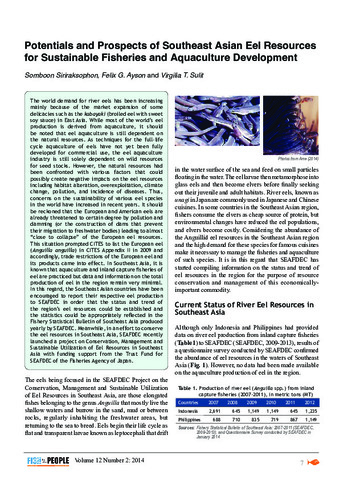High genetic diversity in anguillid glass eels across three Southeast Asian countries revealed through mitochondrial DNA D-loop sequences, with notes on population structure
- Global styles
- MLA
- Vancouver
- Elsevier - Harvard
- APA
- Help

ดู/
วันที่
2024-09ผู้เขียน
Page views
804ASFA keyword
AGROVOC keyword
Geographic names
เมตาดาต้า
แสดงระเบียนรายการเต็ม
Share
นามธรรม
Understanding the genetic diversity and population structure of anguillid eels is crucial for effective management. In this study, we used the mitochondrial DNA (mtDNA) D-loop marker to identify anguillid glass eels and assessed their genetic diversity across six sampling sites spanning three Southeast Asian countries. We also examined the population structures of Anguilla marmorata and A. celebesensis. We validated nine distinct species and subspecies of anguillid eels from 465 specimens collected in Indonesia (n = 246), the Philippines (n = 119), and Vietnam (n = 100). High gene diversities were observed across the species, ranging from 0.979 (A. celebesensis) to 1.000 (A. bicolor bicolor, A. marmorata, and A. interioris). Correspondingly, nucleotide diversity values were relatively low, varying from 0.036 (A. marmorata) to 0.057 (A. interioris). A. marmorata (n = 162) displayed a broad distribution, being observed across all six sites, with a significant yet low average fixation index of 0.05755. Pairwise comparisons of FST values between Cimandiri and other locations (except for Cagayan) were relatively high and statistically significant (p < 0.01), indicating significant genetic differentiation of Cimandiri samples compared to most locations in this study. On the other hand, A. celebesensis (n = 110), exhibited a non-significant and low fixation index (0.007), indicating no genetic differentiation in samples from Poso and Poigar Rivers, Indonesia. Our findings highlight the essential need for coordinated management strategies among regions that share common stocks. Additionally, this study underscores the efficacy of the mtDNA D-loop in precisely identifying glass eel species/subspecies and elucidating the genetic diversity and population structure of tropical anguillid eels.
การอ้างอิง
Marini, M., Pedrosa-Gerasmio, I. R., Santos, M., Romana-Eguia, M. R. R., Nguyen, B. T., & Shibuno, T. (2024). High genetic diversity in anguillid glass eels across three Southeast Asian countries revealed through mitochondrial DNA D-loop sequences, with notes on population structure. Ecological Genetics and Genomics , 32, 100276. https://doi.org/10.1016/j.egg.2024.100276
Type
ArticleISSN
2405-9854คอลเลกชัน
- Journal Articles [1258]
Related items
Showing items related by title, author, creator and subject.
-
Potentials and prospects of Southeast Asian eel resources for sustainable fisheries and aquaculture development
Siriraksophon, Somboon; Ayson, Felix G.; Sulit, Virgilia T. (Secretariat, Southeast Asian Fisheries Development Center, 2014)The world demand for river eels has been increasing mainly because of the market expansion of some delicacies such as the kabayaki (broiled eel with sweet soy sauce) in East Asia. While most of the world’s eel production ... -
Genetic diversity, population structure and demographic history of the tropical eel Anguilla bicolor pacifica in Southeast Asia using mitochondrial DNA control region sequences
Marini, Melfa; Pedrosa-Gerasmio, Ivane R.; Santos, Mudjekeewis; Shibuno, Takuro; Daryani, Ayu; Romana-Eguia, Maria Rowena R. ; Wibowo, Arif (Elsevier, 2021-04)
The tropical catadromous eel, Anguilla bicolor pacifica, an important fishery resource in Southeast Asia, is under threat due to overexploitation (especially of its glass eel phase) and the limited information on their ...
; Wibowo, Arif (Elsevier, 2021-04)
The tropical catadromous eel, Anguilla bicolor pacifica, an important fishery resource in Southeast Asia, is under threat due to overexploitation (especially of its glass eel phase) and the limited information on their ... -
Series: Aquaculture extension manual; No. 65
Nursery culture of tropical anguillid eels in the Philippines
This technical publication focused on nursery production of anguillid eels from glass eels to elver using data gathered from eel farm surveys and rearing trials conducted by SEAFDEC/AQD as part of the JAIF (Japan-ASEAN ...






